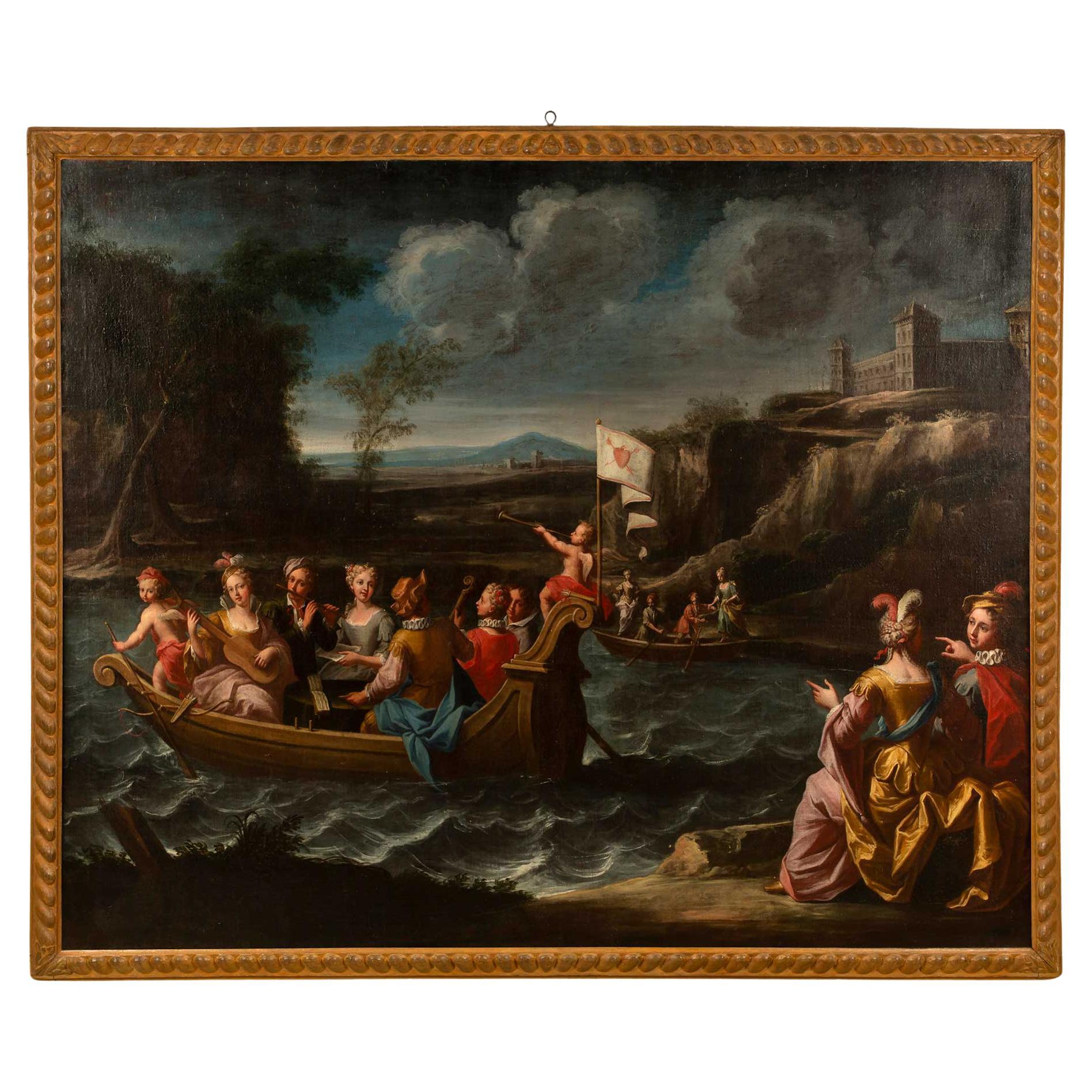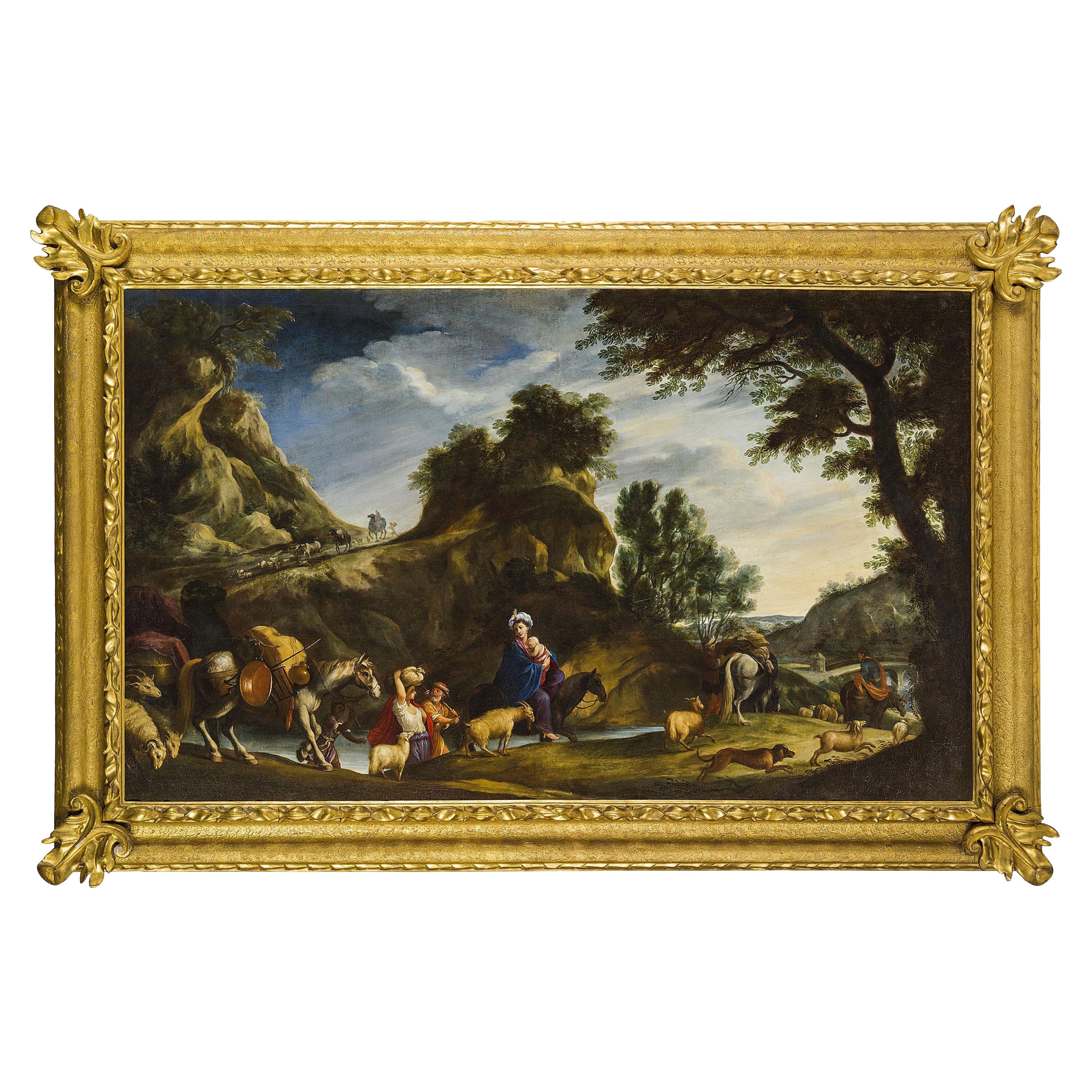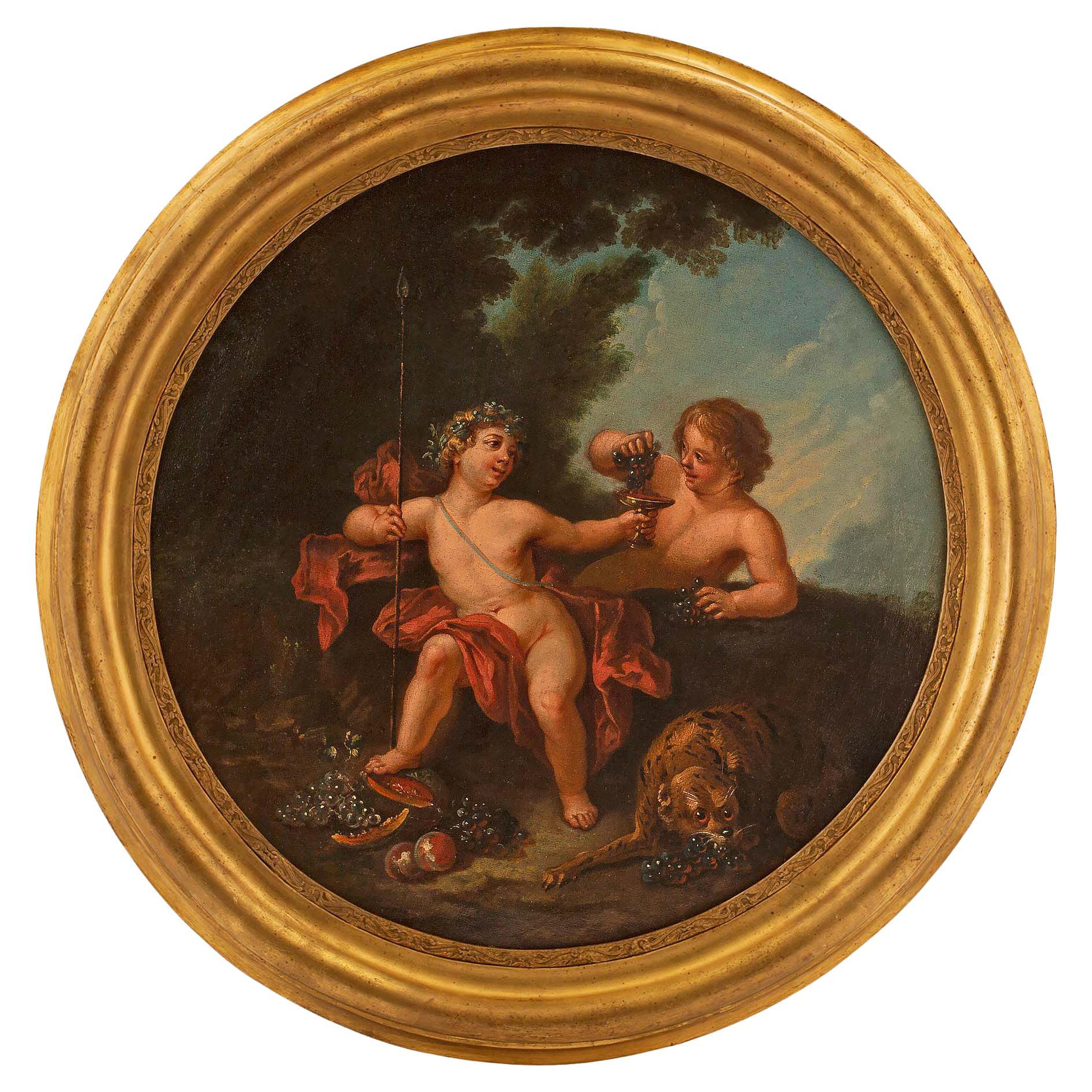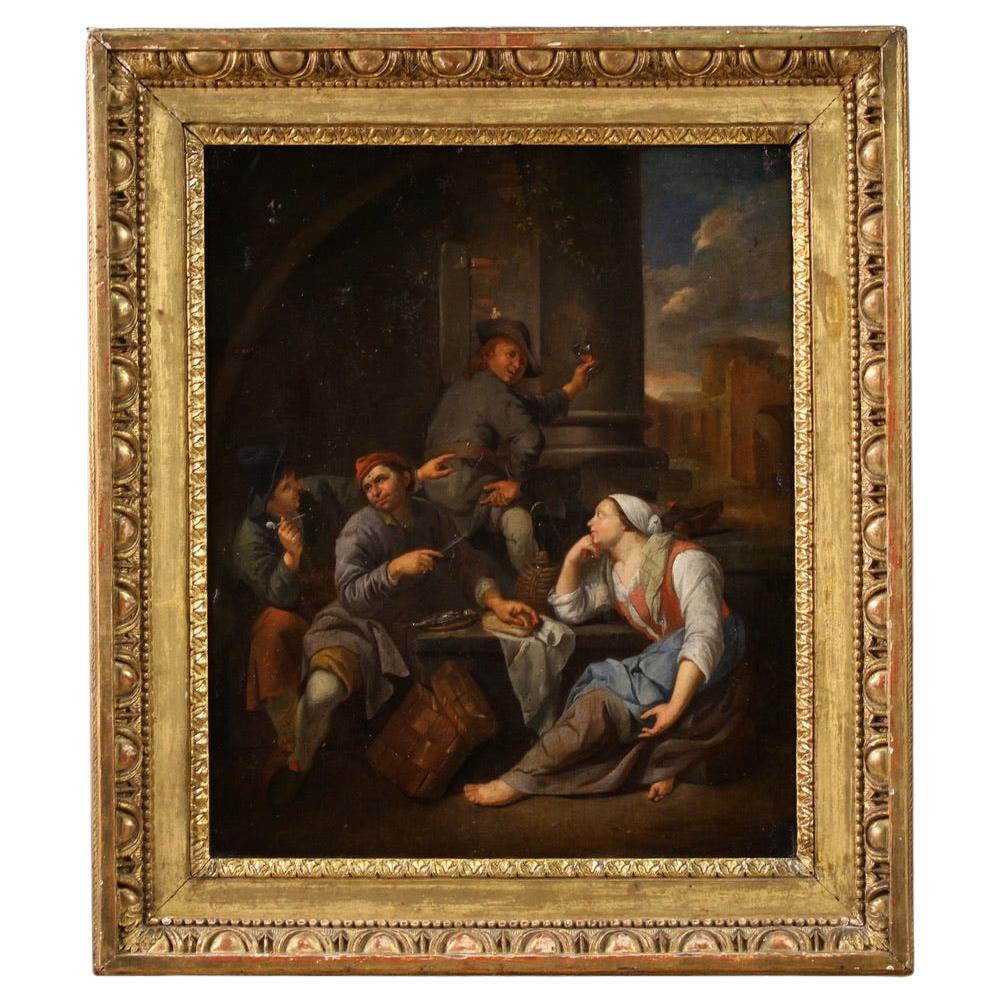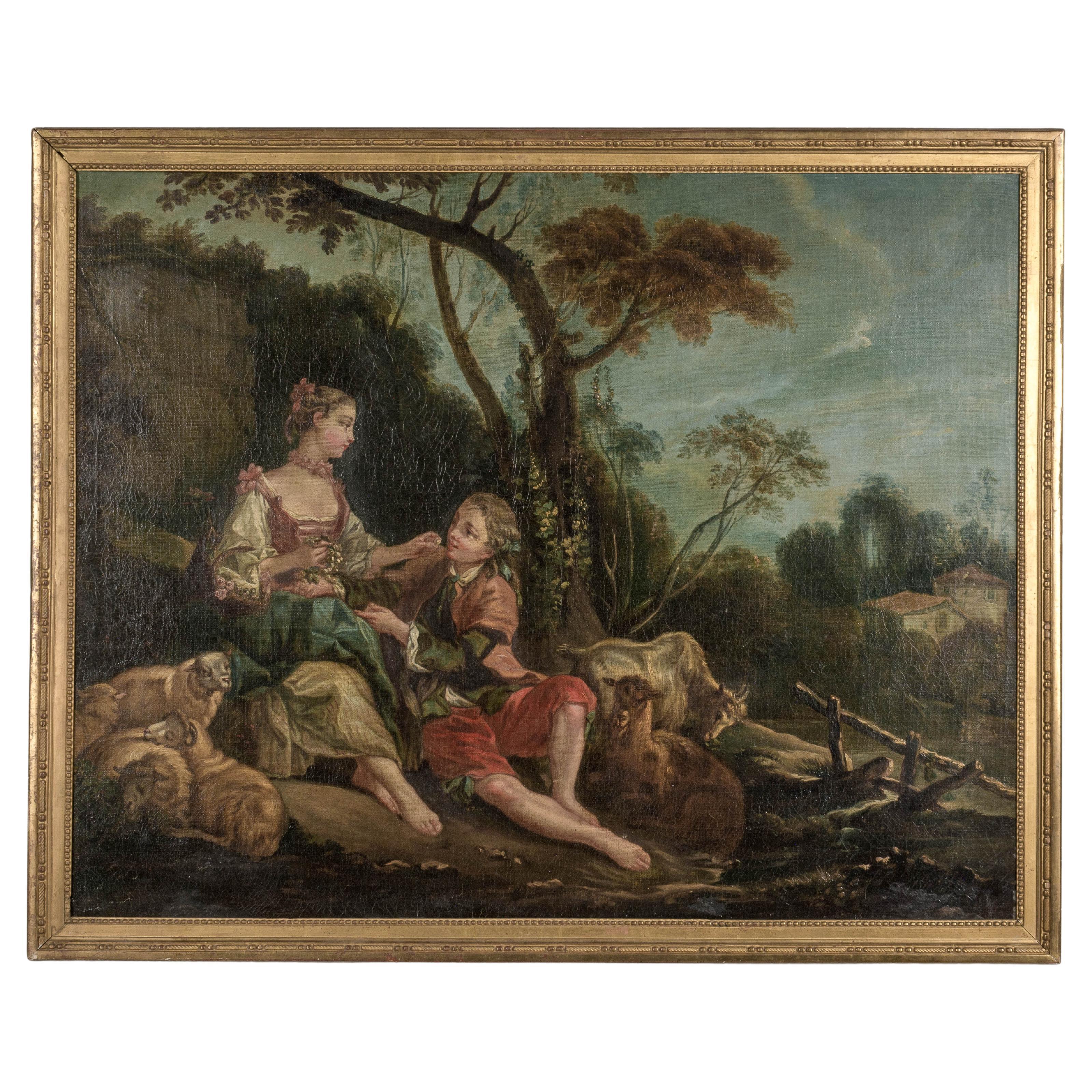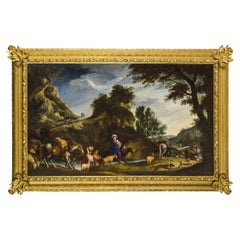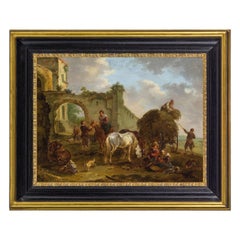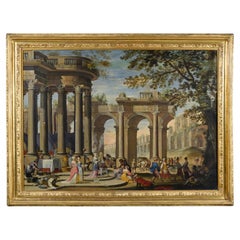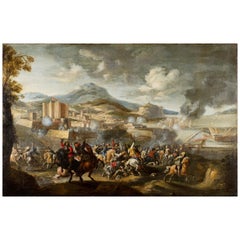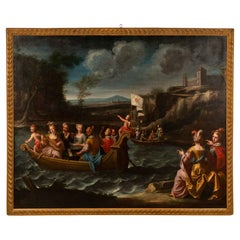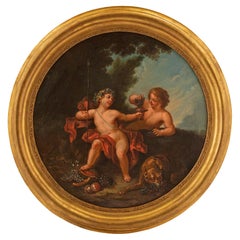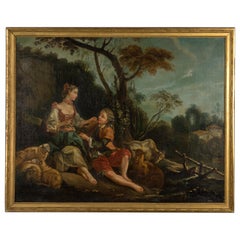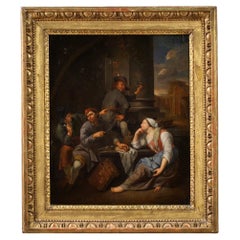Items Similar to 18th Century, Italian painting Depicts Bambocciata by Giovanni Michele Graneri
Want more images or videos?
Request additional images or videos from the seller
1 of 7
18th Century, Italian painting Depicts Bambocciata by Giovanni Michele Graneri
$25,991.96
£19,482.58
€22,000
CA$35,708.53
A$39,865.22
CHF 20,888.77
MX$487,989.37
NOK 265,287.64
SEK 250,132.56
DKK 167,472.03
About the Item
Giovanni Michele Graneri (Italy, Turin 1708-1762)
Bambocciata (Farmers dancing in front of the inn)
The painting, made in oil on canvas, depicts a moment of celebration where some peasants or commoners dance and drink in front of an inn.
The style and quality indicate the autograph of a well-known Piedmontese bambocciante: Giovanni Michele Graneri, one of the protagonists of the fruitful Savoy season of this pictorial genre. Graneri was for a time a parallel and then a continuation of the work of the head of the school Pietro Domenico Ollivero, of which, according to contemporary sources, he was a pupil.
The characters depicted, such as the group of dancers in a circle, the old man with the stick, the bassoon player, the drunk farmer sleeping on the barrel and some observers who look out from the doors, windows or balconies, are characteristic of this kind of representation that is called "bambocciata". The bambocciata is a kind of painting aimed at representing, with vivid figurative and animated effects of light and color, popular scenes of the street, taverns, market, gypsies, in open contrast with the great official baroque painting. It spread widely throughout the eighteenth century and in Piedmont, among the greatest exponents are Pietro Domenico Ollivero (Turin, 1679 - 1755) and Giovanni Michele Graneri (Turin, 1708-1762). The concave shape on the lower side of the frame suggests that the canvas was originally placed in a boiserie in the noble rooms of a noble palace.
Giovanni Michele Graneri was born in Turin on 28 September 1708 to a family of modest economic conditions. On 21 August 1747 he married Francesca Margherita Canicoschi from Turin, with whom he had three children and one daughter. He died on 26 February 1762. The first dated works that we know date back only to 1738, and probably his best known work is the large canvas with the Market of Piazza San Carlo of 1752 (Turin, Museo Civico d'Arte Antica), in which stands out a very accurate description of the square, such as to be credited with landscape painting, then repeated in the other large canvas depicting the Herb Square Market (Sarasota, Florida, John and Mable Ringling Museum). The eighteenth-century sources say he was a pupil of Pietro Domenico Ollivero, the most important and famous painter of genre scenes in Turin, and Graneri’s youthful paintings are strongly affected by the influence both in the general layout and in the rendering of the figures. Like Ollivero, Graneri is part of the trend of the painting of bamboccianti that in Turin had been known through the work of both Jan Miel in the mid-seventeenth century and with the paintings of other Flemish painters, such as David Teniers, called the Younger.
The painter denounces de visu knowledge of some prints from copper engravings taken from works by David Teniers, from which he draws many motifs and subjects; however, he draws only a few elements from them. Graneri in fact practices sophisticated readings of other people’s works, presenting personal interpretations. It absorbs from the Teniers, and from Ollivero, certain architectures that have a Nordic inspiration, the setting of the scene, the old beggar with the stick, the subject leaning or asleep to the barrel, the characters dancing, the inevitable dog, a subject that faces the window. Graneri is also concerned to make the real liveliness of the scene with bright colors and funny details, without dwelling too much on the appearance of the figures, which are similar to each other. Unlike Ollivero, the painter does not want to meditate on the human events he describes, but have fun and make ironically the life that flows around him, exasperating sometimes certain aspects until their deformation.
Graneri’s works are distinguished by the wealth of figures with witty looks, genre scenes and characters engaged in everyday life actions that the author returns with freshness and masterful attention. His works testify to the richness and the social variety that was possible to meet in the Turin of the Savoy and are considered valuable artistic documents as well as historical sources of considerable importance.
We apologize for translation errors. Please contact to have the expertise in Italian
- Dimensions:Height: 63.39 in (161 cm)Width: 56.3 in (143 cm)Depth: 1.19 in (3 cm)
- Style:Baroque (Of the Period)
- Materials and Techniques:
- Place of Origin:
- Period:
- Date of Manufacture:Mid-18th Century
- Condition:Refinished. Wear consistent with age and use.
- Seller Location:IT
- Reference Number:1stDibs: LU4405225241202
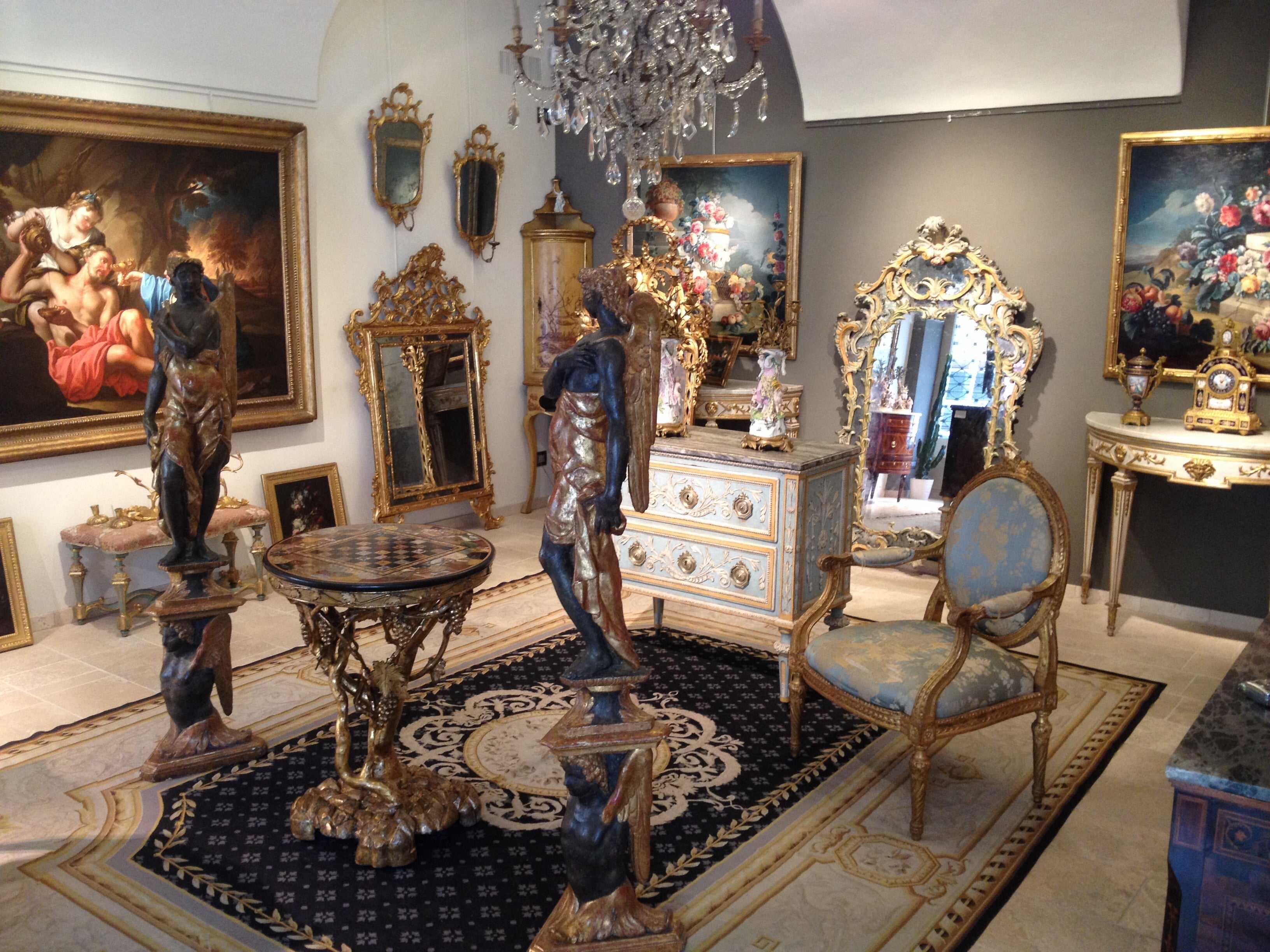
About the Seller
5.0
Platinum Seller
Premium sellers with a 4.7+ rating and 24-hour response times
Established in 1980
1stDibs seller since 2019
56 sales on 1stDibs
Typical response time: 1 hour
- ShippingRetrieving quote...Shipping from: Italy
- Return Policy
Authenticity Guarantee
In the unlikely event there’s an issue with an item’s authenticity, contact us within 1 year for a full refund. DetailsMoney-Back Guarantee
If your item is not as described, is damaged in transit, or does not arrive, contact us within 7 days for a full refund. Details24-Hour Cancellation
You have a 24-hour grace period in which to reconsider your purchase, with no questions asked.Vetted Professional Sellers
Our world-class sellers must adhere to strict standards for service and quality, maintaining the integrity of our listings.Price-Match Guarantee
If you find that a seller listed the same item for a lower price elsewhere, we’ll match it.Trusted Global Delivery
Our best-in-class carrier network provides specialized shipping options worldwide, including custom delivery.More From This Seller
View All17th Century, Italian Painting by Pier Francesco Cittadini, Jacob and his Family
Located in IT
Pier Francesco Cittadini (Milan, 1616-Bologna, 1681)
"Jacob and his family go to Egypt"
Oil on canvas, cm 109 x 190 (canvas only)
The valuable painting, made in oil on canvas, depicts Jacob and his family go to Egypt and we believe it can be, given the high quality painting, autograph work of Italian Pier Francesco Cittadini (Italy Milan, 1616 - Bologna, 1681) made after 1647. The work, in excellent condition is accompanied by a coeval frame in wood finely carved and golden.
The scene depicted, which was confused with the Flight to Egypt in the past years, is instead identified with the biblical episode of Jacob’s journey. In the foreground, reading the painting from left to right, we see a caravan composed of animals, including donkeys, dromedaries, goats, dogs and horses and people, women, men and slaves, who carry on their journey along the banks of a river, following a path that to the right, would seem to lead to the through of a bridge. In addition to the watercourse is described an environment characterized by large rocks and impervious come far to cover the entire verticality of the canvas. On the left, in the distance, we see the tail of the caravan that runs along the steep path. Large trees enliven and harmonize the environment, as well as white and grey clouds characterize the predominantly clear sky and illuminated on the right by sunlight.
The story is told in the Bible, Book of Genesis, 30, 25, passage in which is described the flight of Jacob from Haran after the contrasts with Laban, father of his wife Rachel. Jacob is the third great patriarch of the Bible. From his descendants originate the twelve generations of the people of Israel. He is the son of Isaac and Rebekah, who led him to flee from the wrath of Esau to Haran to seek refuge from his brother, Laban. At his uncle’s house Jacob met his daughter Rachel. As soon as he saw his cousin, Jacob was taken. Jacob will stay seven years in the service of Laban to marry his beloved Rachel. But Laban, with a deception, will give him in marriage first Lia, the least beautiful eldest daughter, and only after another seven years the splendid Rachel. From his first wife he will have several children, while Rachel will give birth to the beloved son, Joseph, who will become viceroy of Egypt.
After years of service, Jacob asked to be paid with every dark-coloured garment among the sheep and every spotted and dotted garment among the goats. Laban accepted and sent away from his sons all the leaders of that kind. So Jacob took fresh branches of poplar, almond and plane tree, and flayed them, and put them in the troughs. The optical suggestion induced the goats and the sheep to conceive and give birth to dark, striped and dotted garments. He also ensured that all the strongest and healthiest leaders of the flock of Laban would drink near the barked branches, thus assuring a genetic superiority to his part of the flock. His flocks grew numerous and strong and he became richer than his relative, arousing envy. It was clear that Laban would not respect him much longer. At the suggestion of the Lord, Jacob decided to return to Canaan. Trying to avoid any possible dispute, he left with his family while Laban was absent for shearing sheep. But when, three days later, his uncle returned home, he became angry, feeling offended because Jacob had gone secretly and had not allowed him to greet his daughters and grandchildren. In addition, his teraphim, statuettes, or idols, which depicted the family deities, had disappeared. After 7 days of pursuit, Laban and his men reached Jacob’s group on Mount Gilead, in the mountainous region west of the Euphrates River, where his uncle and grandson had a stormy conversation. The younger man was outraged at being accused of stealing idols and told Labano to rummage through his family’s tents at will. Neither of them could know or even imagine that it was Rachel who took the idols and hid them in the saddle of the camel. During the search, she sat down firmly on the saddle, apologizing for not being able to get up, «because I usually have what happens to women» (Gen 31:35). So the loot wasn’t discovered.
The author of this work was inspired by the composition of an engraving by Stefano Della Bella (1610-1664) of circa 1647. The engraving by Stefano della Bella bears the title "Iacob sur ses vieux jours quitte sans fascherie pour voir son filz Ioseph, sa terre et sa patrie" and is signed on the bottom left "Stef. of the Beautiful In. et fe." while on the right it is declared "Cum privil. Regis", that is with license of the king.
Stefano Della Bella (Italy - Florence, May 18, 1610-Florence, July 12, 1664) was born in a family of painters, sculptors and goldsmiths and was left early orphan of his father sculptor, he dedicated himself first to the art of goldsmith at the school of Giovanni Benedetto Castiglione and Gasparo Mola, then turning his attention to drawing and engraving. He soon began drawing figures and copying the etchings of Jacques Callot, which inspired his early works. Under the protection of the Medici, in particular of Don Lorenzo, cadet son of Grand Duke Ferdinand I, Della Bella has the opportunity to make study trips to Rome, where he stayed from 1633-1636; In Rome he met French engravers and publishers of prints such as Israël Henriet and François Langlois, who influenced his decision to move to Paris in 1639, four years after the death of Callot. In Paris he soon reached, thanks to the engravings commissioned by Cardinal Richelieu, the success also worldly; he frequented courtiers, theatre artists and writers, while refusing too oppressive honors. In 1646-1647 he continued his travels in the Netherlands to Amsterdam, Antwerp and Dordrecht. He returned to Florence in 1650 and resumed working under the protection of the Medici court, working for his patrons. In 1656 he became a member of the Academy of Apatists.
The painting object of this study is reasonably attributable to Pier Francesco Cittadini, or Pierfrancesco Cittadini, called the Milanese or the Franceschino (Italy - Milan, 1616-Bologna, 1681) as some exemplary stylistic comparisons proposed to follow can prove.
Pier Francesco Cittadini was an Italian baroque painter, mainly active in Bologna.
His artistic training first took place with the painter Daniele Crespi...
Category
Antique Mid-17th Century European Baroque Paintings
Materials
Canvas, Giltwood
18th Century, Baroque Austran Painting by August Querfurt
Located in IT
August Querfurt (1696, Wolfenbüttel - 1761, Vienna)
Farmers and villagers at the entrance of a village
Oil on panel , cm 38,5 x 51. frame 66 x 53,5 x 4,5 cm
The valuable painting, ...
Category
Antique 18th Century Austrian Baroque Paintings
Materials
Wood
18th Century, Painting Architectural Capriccio, att. to Isaac De Moucheron
Located in IT
18th Century, Painting with Architectural Capriccio with figures, attributed to Isaac De Moucheron
Measures: canvas cm H 108 x L 152; with frame cm H 132 x L 176 x 8
The painting i...
Category
Antique 18th Century Dutch Baroque Paintings
Materials
Canvas
17th Century, Italian Painting with Battle attributed to Marzio Masturzo
Located in IT
Marzio Masturzo, attributed (Active in Italy - in Naples and Rome- in the second half of the 17th century)
"Battle between cavalry and vessels with fortified city on the left"
...
Category
Antique Late 17th Century Italian Baroque Paintings
Materials
Canvas
$39,874 Sale Price
25% Off
18th century, Couple of Italian Paintings Capriccio with Mythological Scenes
Located in IT
Couple of architectural capriccio with mythological scenes, oil on canvas, painter from Bologna active in the 18th century
The two large and valuable pantings depict two architectur...
Category
Antique Early 18th Century Italian Baroque Paintings
Materials
Canvas
18th Century, Italian Still Life Painting Attributed to Francesco Lavagna
By Francesco Lavagna
Located in IT
Francesco Lavagna (Italy -Naples 1684-1724)
"Still life with flowers and watermelon and hermas with garden in the background"
The painting, beautifully made and in good condition, d...
Category
Antique Early 18th Century Italian Baroque Paintings
Materials
Canvas
$17,485 Sale Price
20% Off
You May Also Like
Italian 18th Century Oil on Canvas from the Piedmont Region
Located in West Palm Beach, FL
A sensational and large scale Italian 18th century oil on canvas from the Piedmont region. The beautiful painting is set in its original polychrome frame which displays a lovely carv...
Category
Antique 18th Century Italian Paintings
Materials
Canvas, Wood
Italian 18th Century Neo-Classical Oil on Canvas Painting
Located in West Palm Beach, FL
An extremely charming Italian 18th century Neo-Classical oil on canvas painting. The circular painting retains its original giltwood frame with a beautiful mottled designs and finely...
Category
Antique 18th Century Italian Neoclassical Paintings
Materials
Canvas, Giltwood
18th Century French Oil Painting
Located in Winter Park, FL
A late 18th century French painting depicting a romantic couple in a pastoral setting. Oil on canvas. Unsigned. Original gilded wood frame. Small repair to canvas in the upper left c...
Category
Antique Late 18th Century French French Provincial Paintings
Materials
Giltwood, Paint
18th Century Oil on Canvas Flemish Antique Painting Genre Scene, 1770
Located in Vicoforte, Piedmont
Refined Flemish painting from the 18th century. Oil on canvas artwork depicting a lively genre scene, of notable pictorial quality and rich in minute details. In a rustic setting, pr...
Category
Antique 1770s Dutch Paintings
Materials
Canvas
18th Century French Baroque Oil Painting
Located in Winter Park, FL
A late 18th century French painting depicting a romantic couple in a pastoral setting. Oil on canvas. Unsigned. Original gilded wood frame. Small repair to canvas in the upper left c...
Category
Antique Late 18th Century French Baroque Paintings
Materials
Giltwood, Paint, Canvas
Monumental 18th Century Italian Oil Painting
Located in Round Top, TX
A monumental 18th century Oil On Canvas Painting from Lucca, Italy. Delightful soft color and hues with handsome cracquelure. The painting will be the statement of its surrounding.
Category
Antique 18th Century Italian Paintings
Materials
Canvas
